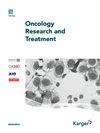Vemurafenib-induced pulmonary injury.
IF 0.3
4区 医学
Q4 Medicine
引用次数: 5
Abstract
a nearly complete remission of the infiltrations 6 days after discontinuation of vemurafenib therapy (fig. 1B). Vemurafenib was administered again at the standard dose (960 mg twice daily) for 2 weeks after withdrawal. 3 weeks after re-initiation of vemurafenib the lung infiltrations worsened again. Because of 2 surgical interventions (uterine metastatic bleeding and non-responding axillar lymph node metastasis) administration of vemurafenib had to be stopped, twice for 3 days in each case. During these, albeit short, treatment pauses the lung infiltrates regressed once again, confirming a causative correlation to vemurafenib treatment. Because of the good response of the target lesions, we decided to continue vemurafenib treatment but at a reduced dose of 720 mg twice daily. Under this regimen, pulmonary infiltrates were no longer observed (fig. 2).vemurafenib诱导的肺损伤。
本文章由计算机程序翻译,如有差异,请以英文原文为准。
求助全文
约1分钟内获得全文
求助全文

 求助内容:
求助内容: 应助结果提醒方式:
应助结果提醒方式:


